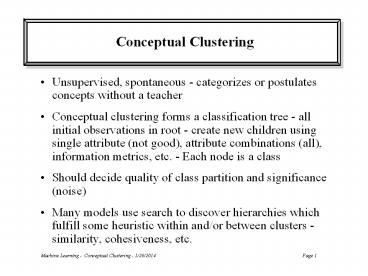Conceptual Clustering - PowerPoint PPT Presentation
Title:
Conceptual Clustering
Description:
... attribute weighted by P(Ai = Vij), with k proposed categories, i attributes, j values/attribute ... Create a new class node done, can get next example ... – PowerPoint PPT presentation
Number of Views:113
Avg rating:3.0/5.0
Title: Conceptual Clustering
1
Conceptual Clustering
- Unsupervised, spontaneous - categorizes or
postulates concepts without a teacher - Conceptual clustering forms a classification tree
- all initial observations in root - create new
children using single attribute (not good),
attribute combinations (all), information
metrics, etc. - Each node is a class - Should decide quality of class partition and
significance (noise) - Many models use search to discover hierarchies
which fulfill some heuristic within and/or
between clusters - similarity, cohesiveness, etc.
2
Cobweb
- Cobweb is an incremental hill-climbing strategy
with bidirectional operators - not backtrack, but
could return in theory - Starts empty. Creates a full concept hierarchy
(classification tree) with each leaf representing
a single instance/object. You can choose how
deep in the tree hierarchy you want to go for the
specific application at hand - Objects described as nominal attribute-value
pairs - Each created node is a probabilistic concept (a
class) which stores probability of being matched
(count/total), and for each attribute,
probability of being on, P(avC), only counts
need be stored. - Arcs in tree are just connections - nodes store
info across all attributes (unlike ID3, etc.)
3
Category Utility Heuristic Measure
- Tradeoff between intra-class similarity and
inter-class dissimilarity - sums measures from
each individual attribute - Intra-class similarity a function of P(Ai
VijCk), Predictability of C given V - Larger P
means if class is C, A likely to be V. Objects
within a class should have similar attributes. - Inter-class dissimilarity a function of P(CkAi
Vij), Predictiveness of C given V - Larger P
means AV suggests instance is member of class C
rather than some other class. A is a stronger
predictor of class C.
4
Category Utility Intuition
- Both should be high over all (most) attributes
for a good class breakdown - Predictability P(VC) could be high for multiple
classes, giving a relatively low P(CV), thus not
good for discrimination - Predictiveness P(CV) could be high for a class,
while P(VC) is relatively low, due to V
occurring rarely, thus good for discrimination,
but not intra-class similarity - When both are high, get best categorization
balance between discrimination and intra-class
similarity
5
Category Utility
- For each category sum predictability times
predictiveness for each attribute weighted by
P(Ai Vij), with k proposed categories, i
attributes, j values/attribute - The expected number of attribute
- values one could guess given C
6
Category Utility
- Category Utility is the increase in expected
attributes that could be guessed, given a
partitioning of categories - leaf nodes. - CU(C1, C2, ... Ck)
- K normalizes CU for different numbers of
categories in the candidate partition - Since incremental, there is a limited number of
possible categorization partitions - If Ai Vij is independent (irrelevant) of class
membership, CU 0
7
Cobweb Learning Algorithm
- 1. Incrementally add a new training example
- 2. Recurse down the at root until new node with
just this example is added. Update appropriate
probabilities at each level. - 3. At each level of the tree calculate the
scores for all valid modifications using category
utility (CU) - 4. Depending on which of the following gives the
best score - Classify into an existing class - then recurse
- Create a new class node done, can get next
example - Combine two classes into a single class (Merging)
- then recurse - Divide a class into multiple classes (Splitting)
- then recurse
8
Cobweb Learning Mechanisms
- Classifying (Matching) - calculate overall CU for
each case of putting the example in a node at
current level - New Class - calculate overall CU for putting
example into a single new class- Note gradient
descent (greedy) nature. Does not go back and
try all possible new partitions. - If created from internal node, simply add
- If created from leaf node, split into two, one
for new and old - These alone are quite order dependent - splitting
and merging allow bi-directionality - ability to
undo
9
Cobweb Learning Mechanisms
- Merging - For best matching node (the one that
would be chosen for classification) and the
second best matching node at that level,
calculate CU when both are merged into one node,
with two children - Splitting - For best matching node, calculate CU
if that node were deleted and its children added
to the current level. - Both schemes could be extended to test other
nodes, at the cost of increased computational
complexity - Can overcome initial misconceptions
10
Cobweb Comments
- Generalization done by just executing recursive
classification step - Could use different variations on CU and search
strategy - Complexity O(AVB2logK) for each example, where B
is branching factor, A (attributes), V (average
number of values), K (classes) - Empirically, B usually between 2 and 5
- Does not directly handle noise - no defined
significance mechanism - Tends to make bushy trees, however high levels
should be most important class categories
(because of merge/split causing best breaks to
float up, though no optimal guarantee), and one
could just use nodes highest in the tree for
classification - Does not support continuous values
11
Extensions - Classit
- Cannot store probability counts for continuous
data - Classit uses a scheme similar to Cobweb, but
assumes normal distribution around an attribute
and thus can just store a mean and variance - not
always a reasonable assumption - Also uses a formal cut-off (significance)
mechanism to better support generalization and
noise handling (a class node can then include
outliers) - More work needed




















![Conceptual Algebra Project [An Ed391 Web Tech Project] PowerPoint PPT Presentation](https://s3.amazonaws.com/images.powershow.com/7706158.th0.jpg?_=201603280112)










